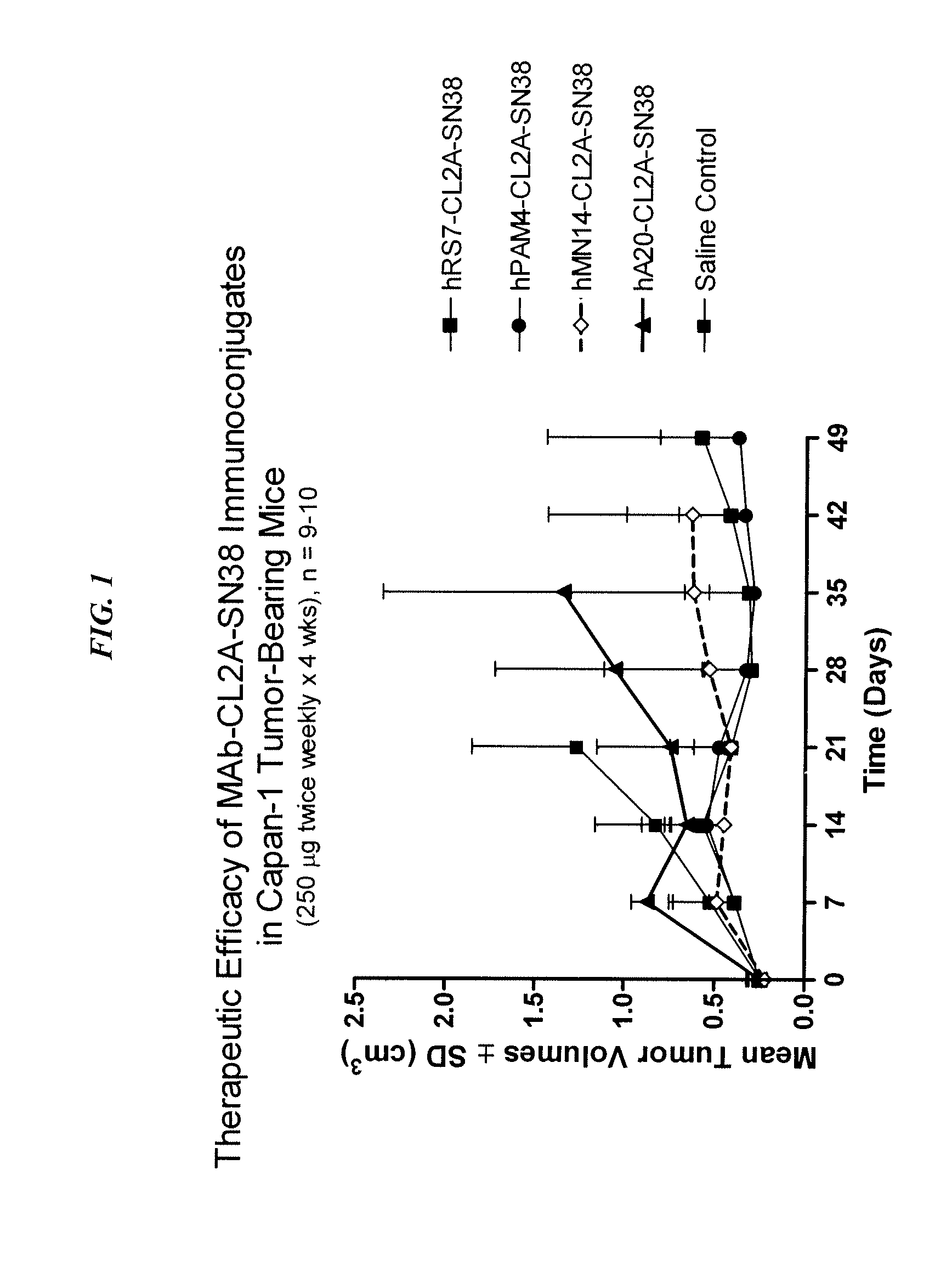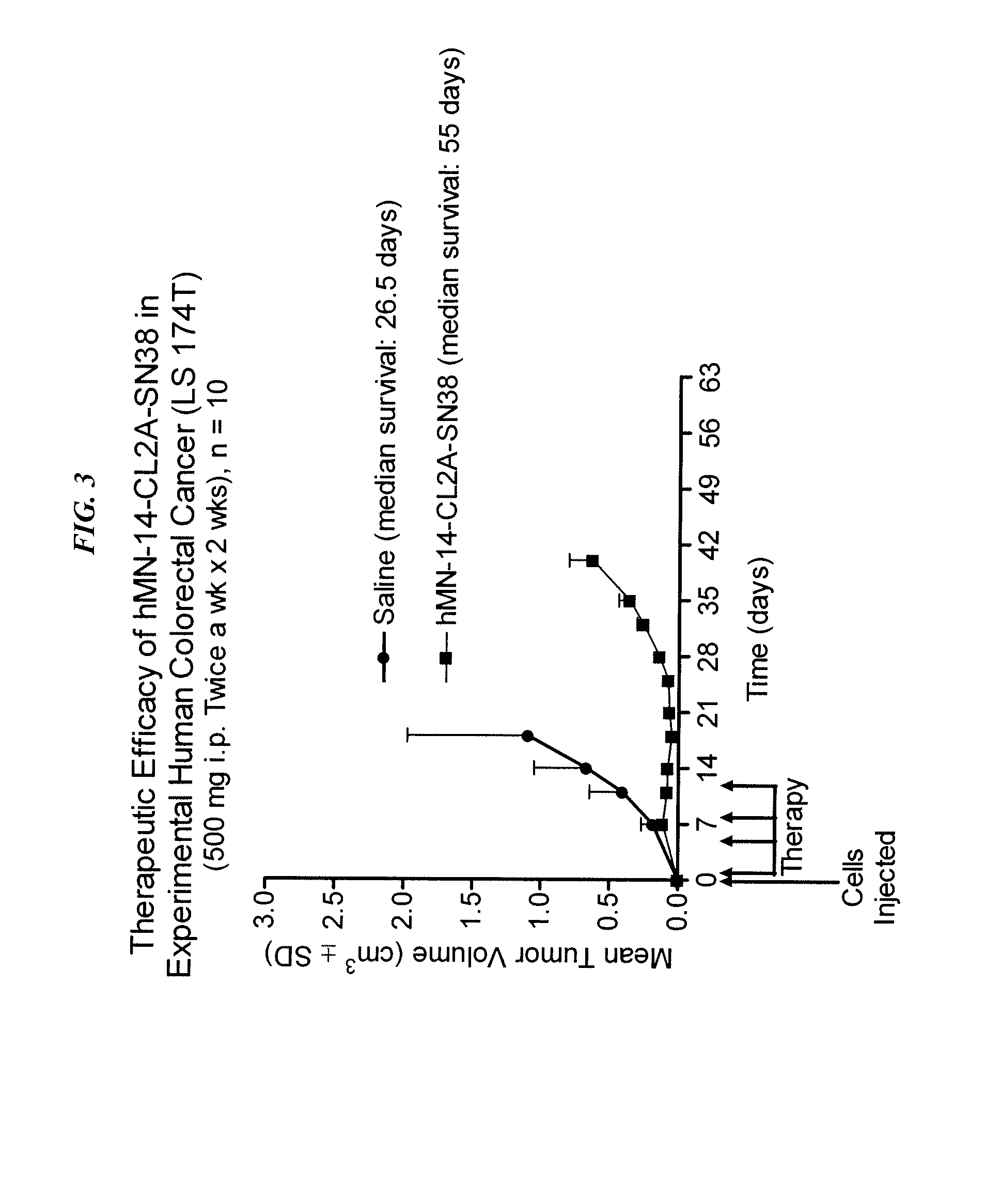Immunoconjugates with an Intracellularly-Cleavable Linkage
a technology of intracellularly-cleaved linkage and conjugate, which is applied in the field of therapeutic conjugates, can solve the problems of mixed success in cancer treatment and no application in other diseases, and achieve the effect of amplifying the number
- Summary
- Abstract
- Description
- Claims
- Application Information
AI Technical Summary
Benefits of technology
Problems solved by technology
Method used
Image
Examples
example 1
Preparation of CL6-SN-38
[0177]CL6-SN-38 is represented in Scheme-1. Commercially available O-(2-azidoethyl)-O′-(N-diglycolyl-2-aminoethyl)heptaethyleneglycol (‘PEG-N3’; 227 mg) was activated with DCC (100 mg), NHS (56 mg), and a catalytic amount of DMAP in 10 mL of dichloromethane for 10 min. To this mixture was added L-valinol (46.3 mg), and the reaction mixture was stirred for 1 h at ambient temperature. Filtration, followed by solvent removal and flash chromatography yielded 214 mg of clear oily material. This intermediate (160 mg) was reacted with 10-O-BOC-SN-38-20-O-chloroformate, the latter generated from 10-O-BOC-SN-38 (123 mg) using triphosgene and DMAP. The coupling reaction was done in 4 mL of dichloromethane for 10 min, and the reaction mixture was purified by flash chromatography to obtain 130 mg (45% yield) of product as foamy material. HPLC: tR 11.80 min; electrospray mass spectrum: M+Na: m / z 1181.
[0178]The maleimide-containing acetylenic reagent, namely 4-(N-maleimido...
example 2
Preparation of CL7-SN-38
[0180]The synthesis is schematically shown in Scheme-2. L-Valinol (40 mg) was reacted with commercially available Fmoc-Lys(MMT)-OH (253 mg) and EEDQ (107 mg) in 10 mL of anhydrous dichloromethane at ambient temperature, under argon, for 3 h. Extractive work up followed by flash chromatography furnished the product Fmoc-Lys(MMT)-valinol as a pale yellow liquid (200 mg; ˜70% yield). HPLC: tR14.38 min; electrospray mass spectrum: M+H: m / z 727. This intermediate (200 mg) was deprotected with diethylamine (10 mL), and the product (135 mg) was obtained in ˜90% purity after flash chromatography. HPLC: tR 10.91 min; electrospray mass spectrum: M+Na at m / z 527. This product (135 mg) was coupled with the commercially available O-(2-azidoethyl)-O′-(N-diglycolyl-2-aminoethyl)heptaethyleneglycol (‘PEG-N3’; 150 mg, 1.1 equiv.) in presence of EEDQ (72 mg, 1.1 equiv.) in 10 mL of dichloromethane, and stirred overnight at ambient temperature. The crude material was purified b...
example 3
Preparation of CL6-SN-38-10-O—CO2Et
[0182]The CL6-SN-38 of Example 1 (55.4 mg) was dissolved in dichloromethane (5 mL), and reacted with ethylchloroformate (13.1 mg; 11.5 μL) and diisopropylethylamine (52.5 mg; 71 μL), and stirred for 20 min under argon. The reaction mixture was diluted with 100 mL of dichloromethane, and washed with 100 mL each of 0.1 M HCl, half saturated sodium bicarbonate and brine, and dried. Flash chromatography, after solvent removal, furnished 59 mg of the title product. HPLC: tR 10.74 min; exact mass: calc. 1404.6457 (M+H) and 1426.6276 (M+Na); found: 1404.6464 (M+H) and 1426.6288 (M+Na).
PUM
| Property | Measurement | Unit |
|---|---|---|
| structure | aaaaa | aaaaa |
| solubility | aaaaa | aaaaa |
| pH | aaaaa | aaaaa |
Abstract
Description
Claims
Application Information
 Login to View More
Login to View More - R&D
- Intellectual Property
- Life Sciences
- Materials
- Tech Scout
- Unparalleled Data Quality
- Higher Quality Content
- 60% Fewer Hallucinations
Browse by: Latest US Patents, China's latest patents, Technical Efficacy Thesaurus, Application Domain, Technology Topic, Popular Technical Reports.
© 2025 PatSnap. All rights reserved.Legal|Privacy policy|Modern Slavery Act Transparency Statement|Sitemap|About US| Contact US: help@patsnap.com



